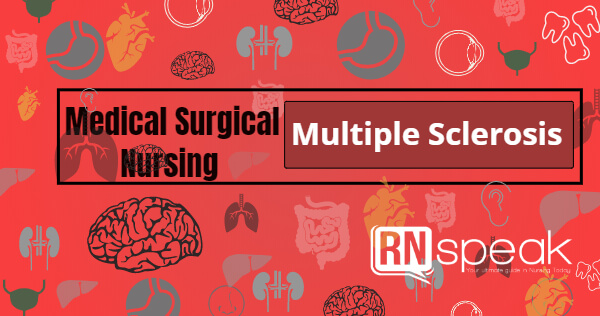Multiple Sclerosis is a condition of the central nervous system and is chronic in nature. This is described as the demyelination of the brain, spinal cord, and optic nerve’s white matter and usually occurs as small patches.
Pathophysiology and/or Etiology
Demyelination is defined as damage to the myelin, the protein, and lipid-rich substance that serves as a cover to the neural fibers of the brain and spinal cord. Due to demyelination, there is a disruption in the nerve transmissions. Eventually, the affected nerve fibers are scarred because of the inflammatory reactions. The cause of this condition is still unknown. However, multiple sclerosis is probably associated with a dysfunctional autoimmune system, vulnerable genetic make-up, or infection. It is common among the Caucasians and among individuals living in the Northern latitudes.
Clinical Manifestations
The small patches, or lesions, can appear in any part of the white matter of the central nervous system. Symptoms of the patient depend on the area where the demyelination happens.
- Body weakness and fatigue
- Unusual reflexes, either hyperactive or absent
- Visual disorders may be nystagmus ( impaired double vision)
- Dysarthria and dysphagia
- Motor disturbances (incoordination and tremor)
- Sensory dysfunctions ( paresthesias, impaired sense of position and vibration, reduced deep sensation)
- Impaired urinary functions (frequency, incontinence, hesitancy, retention, urgency)
- Behavioral patterns ( depression, emotional lability, disturbed cognition)
Diagnostic Examinations
- Electrophoresis – the cerebrospinal fluid is being studied to check for the presence of IgG antibodies.
- Magnetic Resonance Imaging – helpful in visualization of the lesions on the white matter of the central nervous system
- Visual, auditory and somatosensory evoked potentials – conductions that are slower than normal are signs of demyelination
Nursing Diagnoses
- Impaired physical mobility
- Fatigue
- Sensory-perceptual alteration
- Altered urinary elimination
- Altered family processes
- Sexual dysfunction
Medical Management
a. Acute cases
- Corticosteroids or adrenocorticotrophic hormone – are necessary to minimize inflammation and reduce the extent of exacerbation or relapse.
- Immunosuppressive agents – provides stabilization throughout the course of the condition
- Beta-interferon (Betason) – for relieving quick-advancing symptoms for some patients
b. Chronic cases
- Anti-spasmodic agents such as Baclofen (Lioresal), Dantrolene (Dantrium) and Diazepam (Valium). Muscle spasms are managed by physical therapy, neural blocks and surgery.
- Amantadine (Symmetrel) for reducing fatigue
- Anti-depressant drugs and counseling
- Anticholinergics for bladder control; intermittent catheterization to facilitate drainage
- Stool softeners, suppositories and bulk laxatives for bowel movement
- Carbamazepine (Tegratol) for dystonia
- Phenytoin (Dilantin)and perphenazine with amitriptyline (Triavil) for pain syndromes
Nursing Management
a. Stimulating motor function
- Instruct to perform everyday exercises that are both helpful to strengthen and stretch the muscles.
- Teach how to perform stretch-hold-relax activities to reduce muscle spasms and contractures.
- Before muscle stretching, apply ice packs to minimize spasm.
- Advise to take frequent rest periods and avoid muscle fatigability as much as possible.
- Encourage to do activities and ambulate as tolerated.
- Instruct on the proper use of assistive devices such as braces, canes and walkers.
b. Reducing fatigue
- Inform about fatigue and how it is an integral symptom of multiple sclerosis.
- Make a plan of activities for each day. Make sure there are enough rest periods in between activities.
- Encourage to use techniques that conserve energy such as sitting while doing some activities and pushing or pulling objects instead of lifting them up.
c. Enhance sensory function
- Recommend to make use of an eye patch if experiencing double vision.
- Orient to the surroundings; keep personal belongings and furniture on fixed arrangement.
- Advise making use of other senses to compensate for reduced sensation.
- Provide a clutter-free and safe environment.
d. Maintaining urinary elimination
- Ensure adequate hydration to prevent urinary tract infection and stones.
- Use a catheter to expel retained urine.
- Set up on a bladder training program to lessen incontinence episodes.
Complications
- Respiratory disorders
- Respiratory, bladder and blood infections
- Complications resulting from immobility
Reference
- The Lippincott Manual of Nursing Practice 6th edition edited by Nettina, Sandra M.









Thanks so much for your work.